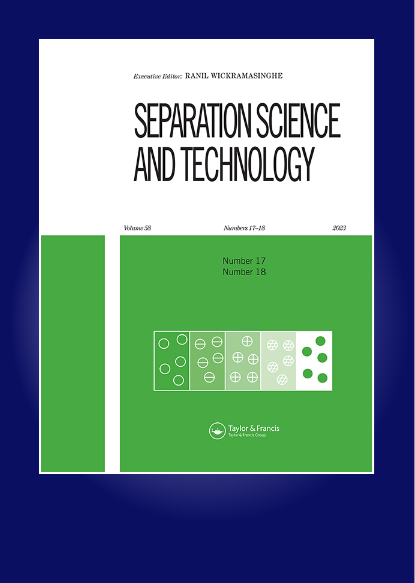智能双响应藻酸酯接枝共聚水凝胶从水中吸附顽固性亚甲基绿
IF 2.3
4区 工程技术
Q3 CHEMISTRY, MULTIDISCIPLINARY
引用次数: 0
摘要
摘要水生介质中难降解染料的吸附脱除在当代研究中具有重要意义。通过对海藻酸钠接枝聚(n -异丙基丙烯酰胺-共丙烯酸)[Na-Alg-g-p(NIPAm-co-AAc)]水凝胶吸附亚甲基绿(MG)的简单制备和后续吸附研究,解决了这一紧迫问题。吸附剂在30分钟内达到平衡,而在最佳pH为5时,吸附剂的吸附量最高。在25℃时,吸附质吸附量随初始浓度的升高而增加。等温研究的数据与Langmuir等温线的拟合程度较高,R2为≈0.98。实验得到的二阶速率常数与理论计算的二阶速率常数基本一致,且R2(0.999)异常高。Langmuir等温线和拟二级动力学模型的有效性表明阴离子[Na-Alg-g-p(NIPAm-co-AAc)]吸附剂与阳离子MG之间发生了化学吸附。此外,材料表现出双重(pH和温度)响应性质,因为吸附量随温度和pH的变化而变化。结果表明所制备的吸附剂在染料污染水的回收和相关应用中具有潜在的候选性。关键词:吸附去除难降解染料制备聚合物凝胶吸附实验补充数据本文的补充数据可在https://doi.org/10.1080/01496395.2023.2279516Disclosure上在线获取声明作者未报告潜在的利益冲突。采用自由基聚合法制备了双反应型海藻酸钠接枝聚(n -异丙基丙烯酰胺-共丙烯酸)[Na-Alg-g-p(NIPAm-co-AAc)]水凝胶。以亚甲基绿(MG)为探针染料,对接枝共聚物材料的吸附行为进行了间歇吸附实验。采用不同的吸附动力学和等温线模型对吸附动力学和等温线进行了研究。采用丙酮溶剂萃取法对负载MG的吸附剂进行了再生,并对废吸附剂的回收性能进行了连续6次的吸附-解吸试验。结果表明所制备的吸附剂在染料污染水的回收和相关应用中具有潜在的候选性。本文章由计算机程序翻译,如有差异,请以英文原文为准。
Smart dual responsive alginate grafted copolymeric hydrogel for sorption of recalcitrant methylene green from water
ABSTRACTThe sorptive removal of recalcitrant dyes from aquatic media holds paramount significance in the contemporary research. The pressing problem has been addressed by facile fabrication and subsequent sorption studies on sodium alginate grafted poly (N-isopropyl acrylamide-co-acrylic acid) [Na-Alg-g-p(NIPAm-co-AAc)] hydrogel for sorption of methylene green (MG). The sorbent achieved equilibrium in 30 minutes, whereas highest sorption capacity was noted at optimum pH 5. At 25°C, the sorbed quantity of the adsorbate enhanced with the rise in initial concentration. The data of isothermal studies fitted well into the Langmuir isotherm as suggested by relatively higher R2 of ≈ 0.98. The sorption obeyed pseudo-second-order kinetics as evidenced by exceptionally higher R2 (0.999) and substantial agreement in experimentally obtained and theoretically calculated second-order rate constant. The validity of Langmuir isotherm and pseudo-second-order kinetic models imply the occurrence of chemisorption between anionic [Na-Alg-g-p(NIPAm-co-AAc)] sorbent and cationic MG. Moreover, the material exhibits dual (pH and temperature) responsive nature because the amount sorbed undergoes variation with change in temperature and pH. The results signify potential candidature of the fabricated sorbent for the reclamation of dye contaminated water and related applications.KEYWORDS: Sorptive removalrecalcitrant dyesfacile fabricationpolymeric hydrogelsorption experiments Supplemental dataSupplemental data for this article can be accessed online at https://doi.org/10.1080/01496395.2023.2279516Disclosure statementNo potential conflict of interest was reported by the author(s).Novelity statementDual responsive sodium alginate grafted poly (N-Isopropyl acrylamide-co-acrylic acid) [Na-Alg-g-p(NIPAm-co-AAc)] hydrogel was fabricated by free radical polymerization method.Sorption behaviour of the graft co-polymeric material was explored in batch adsorption experiments by using methylene green (MG) as a probe dye.The sorption kinetics and isotherm were probed by applying different kinetic and isotherm models.The MG loaded sorbent was regenerated by adopting solvent extraction route using acetoneThe recycling behaviour of the spent sorbent was inspected for six successive sorption-desorption runs.The results signify potential candidature of the fabricated sorbent for the reclamation of dye contaminated water and related applications.
求助全文
通过发布文献求助,成功后即可免费获取论文全文。
去求助
来源期刊

Separation Science and Technology
工程技术-工程:化工
CiteScore
6.10
自引率
3.60%
发文量
131
审稿时长
5.7 months
期刊介绍:
This international journal deals with fundamental and applied aspects of separation processes related to a number of fields. A wide range of topics are covered in the journal including adsorption, membranes, extraction, distillation, absorption, centrifugation, crystallization, precipitation, reactive separations, hybrid processes, continuous separations, carbon capture, flocculation and magnetic separations. The journal focuses on state of the art preparative separations and theoretical contributions to the field of separation science. Applications include environmental, energy, water, and biotechnology. The journal does not publish analytical separation papers unless they contain new fundamental contributions to the field of separation science.
 求助内容:
求助内容: 应助结果提醒方式:
应助结果提醒方式:


